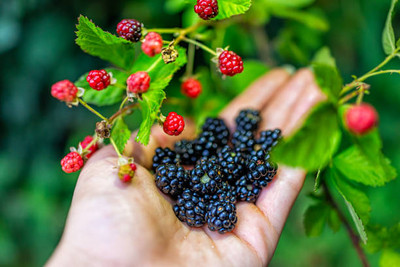Discover the joys of foraging
Posted by The Wares Team on 8th Sep 2021
September is the perfect season to discover the many joys of foraging. Autumn is in fact the classic time to forage in the hedgerows and woodlands - not to mention coastal areas - with an interesting array of produce available.
You'll find jewelled berries, ripening nuts, interesting leaves and all manner of other treats to discover. If you're knowledgeable, or can sign up for a guided tour or course, mushroom and fungi foraging is also hugely satisfying and interesting. And the meals that you can enjoy are in a league of their own!
What can I forage for in September?
Line up those glass jars because there is plenty to look out for in the countryside over the coming weeks and into October:
Beech nuts
Each beech tree will be covered with a bumper nut crop every 4-5 years, and they are hotly fought over by badgers, birds, and squirrels. If you do find beech nuts, they tend to hang in trios, and they may be abundant. Nibble on the triangular seeds as you forage or add them to risotto or salads. They are all wonderful when roasted in the oven.
Hawthorn berries
In the past, people often ate hawthorn berries with the leaves, which created the traditional name 'bread and cheese'. Hawthorn berries are great when they are cooked and they work well in jellies, jams, ketchup and vinegar. Look for deep red and ripe haws and cook them quickly before bottling them in jam jars or larger glass jars.
Rosehips
Save plenty for the birds, but pink and red rosehips are packed with vitamin C and also make great jams, jellies and delicate pouring sauces for ice cream. They have a gently sweet flavour of their own and work well with mint and other berries.
Sloes
Look for these proud blue berries on the blackthorn, which appear from September and are best after the first frost - or being frozen in your freezer. The fruits are acidic and tart and used to make sloe gin. Sloes are also delicious in jams, vinegar and whiskey and the berries can be picked from the end of this September, through to December. In some years you'll find sloes everywhere along fields and hedgerows.
Wild raspberries and strawberries
These are harder to find, but there are still plenty of spots around the UK where you can forage wild strawberries and wild raspberries. Enjoy them as you would shop-bought varieties, preferably with ice cream or cream! Again, they are the perfect ingredient for jams and jellies.
Blackberries
Children will love to pick blackberries which are abundant along hedgerows and fields about now. They also make wonderful crumbles, baking additions, jams, jellies, liqueurs and more. Just imagine how beautiful a line of crab apple and berry jams will look in pretty glass jars on your dresser this winter - or gifted at Christmas!
Line up your jam jars!
Whether you fancy trying your hand at making jam, jelly, wine or syrups this autumn, make sure you have plenty of glass jars in stock for your creations. These will need to be sterilised first and sealed afterwards with the appropriate screw top lid or snap cap. Don't forget your jam jar toppers and labels either!
You can find plenty of recipes online to help you make jam or jelly and make the most of a glut. Try this one below to get you started:
Blackberry jam for beginners
Layer up 1.8kg of blackberries and 1.5 kg of specialist jam sugar which will have added pectin. Place these in a large bowl and leave them overnight at room temperature with a cover. This will help the sugar to begin dissolving.
Put a saucer in the freezer before you begin and then get a very large pan. The wider and larger it is, the quicker the jam will be ready, so you may want to buy a proper preserving pan. Tip in the berries, juices and sugar from the bowl and stir in the juice of a lemon. Put the pips into a piece of muslin and then add them to the pan as well - this will help to bring more pectin to the mix and help the jam to set.
Stir the mix over low heat until the sugar dissolves and then simmer it for five minutes. Turn the heat off and place a little of the hot jam syrup onto your chilled saucer. When it is cooled, gently push it to look for the 'wrinkle' that tells you the setting point has been met. If there isn't the tell-tale wrinkle, heat the berries and sugar in the pan and then boil them again for a couple of minutes.
Finally, skim off any scum, add a little knob of butter if you like to remove any scum that you miss, and then wait for 15 minutes before you ladle your delicious jam into your sterilised glass jam jars. It'll now keep for six months and make your toast taste better than ever in the morning!

